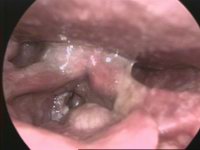Laryngeal Cancer
Laryngeal cancer, also known as throat cancer or laryngeal carcinoma, is a type of cancer that develops in any part of the larynx. It is commonly a squamous-cell carcinoma, originating from the epithelium of the larynx.
The larynx is anatomically divided into three regions: the glottis (true vocal cords and commissures), the supraglottis (epiglottis, arytenoids, aryepiglottic folds, and false cords), and the subglottis. Most laryngeal cancers originate in the glottis, with supraglottic and subglottic tumours being less common.

Signs and Symptoms
The symptoms of laryngeal cancer vary based on the size and location of the tumour. Common symptoms include hoarseness or other voice changes, a lump in the neck, a sore throat or the sensation of something being stuck in the throat, persistent cough, stridor (a high-pitched wheezing indicative of a narrowed or obstructed airway), bad breath, earache due to referred pain, and difficulty swallowing. Treatment can lead to adverse effects such as changes in appearance, difficulty eating, dry mouth, or loss of voice, necessitating alternate methods of speaking.
Risk Factors
The primary risk factor for laryngeal cancer is tobacco smoking, with the heaviest smokers facing a 20-fold increase in mortality risk compared to non-smokers. Heavy alcohol consumption, particularly of spirits, also significantly increases risk. Combined use of alcohol and tobacco accounts for 89% of laryngeal cancer cases. Occupational exposure to certain environmental factors such as wood dust, paint fumes, and chemicals used in various industries is also a risk factor. Some forms of HPV infection carry a risk for laryngeal carcinoma. Additional risk factors include a history of head and neck cancer, low socioeconomic status, male sex, and age over 55 years.
Diagnosis

Diagnosis involves a combination of medical history, physical examination, and special investigations such as chest x-rays, CT or MRI scans, and tissue biopsy. Examination of the larynx may be performed using indirect laryngoscopy or fibre-optic nasal endoscopy. Biopsies, often conducted under general anaesthetic, provide histological proof of cancer type and grade. In cases where the lesion is small and well-localised, excision biopsy may be performed to remove the tumour completely.
Staging
Laryngeal tumours are classified according to guidelines from organisations such as the National Comprehensive Cancer Network (NCCN). Staging evaluates the tumour (T), lymph node involvement (N), and presence of distant metastases (M). The specific criteria for staging include:
- Tumour (T): Ranges from TX (unable to assess) to T4 (advanced tumours with extensive invasion).
- Lymph Nodes (N): Ranges from NX (unable to assess) to N3 (tumours with extensive lymph node involvement).
- Metastasis (M): M0 indicates no distant metastasis, while M1 indicates presence of distant metastasis.
Treatment

Treatment varies based on tumour location, type, and stage. It may involve surgery, radiotherapy, chemotherapy, or combinations thereof. Surgical treatment can include partial or full removal of the tumour and potentially neighbouring tissues. Adjunct treatments like chemotherapy or radiotherapy may be used before, during, or after surgery. Successful treatment often requires a multi-disciplinary approach, involving physical therapists, speech therapists, psychologists, and various medical specialists.
Epidemiology
Laryngeal cancer incidence is five per 100,000 in the US, with an estimated 12,410 new cases in 2019. The number of new cases is decreasing annually by 2.4%, likely due to reduced cigarette smoking. Globally, there were 177,422 new cases and 94,771 deaths due to laryngeal cancer in 2018. It is considered a rare disease in the US, affecting fewer than 200,000 people.
Self-assessment MCQs (single best answer)
Which part of the larynx is most commonly affected by laryngeal cancer?
What is the primary risk factor for laryngeal cancer?
What are the components of the TNM staging system for laryngeal cancer?
Which of the following is NOT a common symptom of laryngeal cancer?
Which diagnostic method is used for histological proof of laryngeal cancer type and grade?
Which occupational exposure is a risk factor for laryngeal cancer?
What is the estimated number of new laryngeal cancer cases in the US in 2019?
What is the purpose of adjunct treatments like chemotherapy or radiotherapy in laryngeal cancer management?
What percentage of laryngeal cancer cases are associated with the combined use of alcohol and tobacco?
Which of the following is an adverse effect of laryngeal cancer treatment?
Dentaljuce
Dentaljuce provides Enhanced Continuing Professional Development (CPD) with GDC-approved Certificates for dental professionals worldwide.
Founded in 2009 by the award-winning Masters team from the School of Dentistry at the University of Birmingham, Dentaljuce has established itself as the leading platform for online CPD.
With over 100 high-quality online courses available for a single annual membership fee, Dentaljuce offers comprehensive e-learning designed for busy dental professionals.
The courses cover a complete range of topics, from clinical skills to patient communication, and are suitable for dentists, nurses, hygienists, therapists, students, and practice managers.
Dentaljuce features Dr. Aiden, a dentally trained AI-powered personal tutor available 24/7 to assist with queries and provide guidance through complex topics, enhancing the learning experience.
Check out our range of courses, or sign up now!


